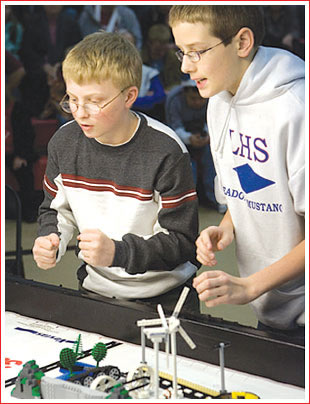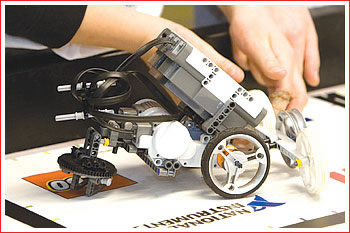Robotics in Idaho for K-12 kids
Hooking Idaho youth on math and science through fun
by DIANE RONAYNE
IT’S NOT YOUR GRANDPAPPY’S 4-H. Today, boys and girls are as likely to write computer programs as show livestock in their 4-H clubs. They’re preparing for a world their grandparents couldn’t have foretold—and still having fun.
The new 4-H Idaho robotics program, under the umbrella of the University of Idaho Extension in the College of Agricultural and Life Sciences (CALS), is an example.

In 2006, UI’s Moscow-based 4-H youth development specialist Tim Ewers launched a Junior FIRST LEGO League for Idaho’s 6- to 9-year-olds and a FIRST LEGO League for 9- to 14-year-olds.
Teams are formed from 4-H clubs, schools, after-school programs, and neighborhood friends.
By 2008, Idaho boasts 73 teams engaging more than 1,000 young minds in designing, building, and programming robots for local and regional competitions. All are made with LEGO bricks (see story p. 29). In the process, robotics teammates learn skills for the 21st-century workplace and address real-world problems such as energy conservation.
UI goal: A K-12 Idaho pipeline for scientists, engineers
Jean Teasdale, assistant dean for research and student outreach in the UI College of Engineering, co-leads the Idaho robotics program with Ewers. Their goal is to create a cohesive, multi- year series of activities to excite students about science and math on their journey from kindergarten through high school.
IDAHO ROKS: Most comprehensive in US?
They call it Idaho Robotics Opportunities for K-12 Students, or Idaho ROKS. Idaho ROKS may be the most comprehensive K-12 effort in the United States.
The university’s 4-H robotics initiative partners with the Idaho Space Grant Consortium, sponsored by NASA and the UI College of Engineering. That consortium began in the mid-1990s to promote robotics competitions among Idaho fifth and sixth graders; Becky Highfill coordinates it today.
By adding 4-H to the mix, younger and older children are introduced to science and math through school teams, after-school programs, summer camps, and competitions. It’s none too soon.
Meeting Idaho’s math, science gap
With only 31 percent of the nation’s fourth graders and 39 percent of eighth graders deemed proficient in science and technology, inspiring youth toward careers in these areas is now a state and national priority.
Idaho’s report card shows only 30 percent of the Gem State’s 2005 grade 8 students are “at or above proficiency” in math. In 2005, Idaho ranked 20th in the nation for grade 8 math scores.
4-H can help improve those numbers.
“Our efforts so far show building robots and the fun of regional competitions hook kids on so many facets of math and science,” says Ewers.
He and Teasdale seek UI students and faculty in engineering and science to mentor K-12 teams. “We want our 4-H kids to get to know university scientists and engineers, so eighth-graders can see themselves attending college.”

Idaho’s first national robot event
I got my first clue about the kind of event Idaho’s first nationally sanctioned robotics championship would be from names emblazoned on team t-shirts: Hot Pink Hairy Headed Hippies, Nine Nutty Robotics Nerds, Six Itty Bitty Kitties & The The Bull Dog, and Panic Stricken Brainy Chickens.
Meridian’s Sawtooth Middle School gym was a whirlwind of sound and movement all afternoon on January 26, 2008. Each of 34 compet- ing teams—most a mix of boys and girls—had survived earlier regional events in Pocatello and Post Falls.
Two 4- by 8-foot tables near bleachers allowed fans to watch four teams at a time send their ‘bots out to accomplish up to 13 challenge project missions in just 2:30 minutes. Boys and girls hollered encouragement and directions while robots competed against the clock in front of referees and judges.
Two ‘bot controllers from each team, often with programming notes penned on their hands, maneuvered robots through tasks—place a solar panel on the roof of a LEGO house, replace a truck with a hydrogen car, deliver a truck to a farm to be repurposed. They lost points for touching.
Teammates hovered nearby cheering each mission accomplished. Points projected onto a large screen let cheering, waving spectators follow each match’s results.
Judging ingenuity, courtesy
Judges—most affiliated with the UI College of Engineering or the Idaho Space Grant Consortium—considered students’ research quality, innovative solutions, and presentation creativity.
Judges also wanted to see teamwork, respect, integrity, and something founders call “gracious professionalism.” Just as in adult science circles, these values lie at the heart of the FIRST LEGO League.
“Our teamwork award recognizes that sometimes collaboration means you don’t get to do your idea, but you learn to make a better robot by compromising to make a team design,” says Ewers. “When kids get into this program there’s so much work to do they see they can’t do it all alone. And there’s gender parity here—a lot of girls participate. That’s good for boys to see.”
Judges selected the top 10 teams in each category (research presentation, robot design, teamwork, and robot performance).
It wasn’t easy. At day’s end, the top trophy went to the Super Battle Droids, Draper, Utah. Two Idaho teams were invited to international tournaments. Moscow’s Circuit Breakers hoped to attend the High Tech Kids International Open in Minnesota in May.
4-H and Idaho school leaders seek funds to allow even more Idaho students to build robots.
Contact Tim Ewers at tewers@uidaho.edu.
DIANE RONAYNE is a Boise-based free-lance writer/editor/photographer.
|